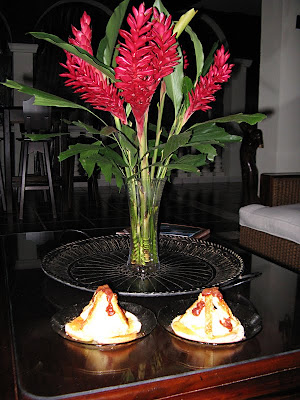Chatto is the cluster of mountains just south of Volcan Arenal. From downtown La Fortuna, they resemble a sleeping man with a round nose, a large belly and an erection. At the top of Chatto is a lagoon. I scaled the mountain to reach it Wednesday.
The Circa de Cataratas ends less than a kilometer away from the Abercam resort in an open stable and a parking lot with several squat brown buildings. The Chatto trailhead is up the hill to the right.
Butterfly weed, white ginger, torch ginger, ornamental bananas, plumerias, and several other recognizable cultivars flanked the circuitous route to the trailhead. I crossed a lichen covered log bridge.
A network of slick grasses are perhaps the best way to keep the muddy hillside from erroding. The barbed wire fences bordering them, however, are dangerous for those who slip, so I took extra caution in this area.
After 45 minutes, I reached the trailhead. The views of downtown La Fortuna and environs were most impressive here. A sign suggested the remaining hike was 1750 meters or a little over a mile.
The first portion of the trail was log steps braced with iron stakes. Towering narrow trees on either side formed a protective cover from the light rain.
Though the wildlife on the trail was limited at the time of day I traveled, I did see many unusual sights.
The range of mushrooms on the trail impressed me. I’d never seen nokki mushrooms in the wild or candy cap mushrooms that were as large as the specimens here. There was a ribbon like fungus that resembled green lasagna noodles, a matte black mushroom that resembled jet, and several wood-ear varieties.
The mosses were also notable. Wet or dry, they seemed to cover every tree. One frosty groundcover resembled tiny interlocking green coins.
Ants were surprisingly scarce, perhaps due to an overplus of tiny frogs. Several times, I was pursued by curious white mosquitos.
With about 750 meters to go, the difficulty of the hike changed significantly. Where sure footholds had been carved into rock there was now only wet soil. Pulling oneself up by tree roots was sometimes the only means available to advance along the trail. I had to pause and stategize periodically.
I did not carry water and was somewhat dehydrated. Several times between the 350 and 170 meters marks I sat down to clear my head.
I never doubted that I would complete the climb. I did wonder why I’d decided to pursue it. I wondered if the lagoon at the end would be worth the trouble. I was grateful that the trail was here, that the climb was possible, but questioned what humankind is doing at places like Cerro Chatto? Are we really more likely to protect nature if we come in contact with it in this way?
The last 170 meters was straight down the edge of the crater to the lagoon. There were fewer footholds and many dangerous loose branches. It is here that a knowledgable guide taking the path in advance of the hiker would be most rewarding.
The trail tailed out at the water’s edge, a seven foot square clearing with a bench. A large tree extended a branch over the water that would be excellent to climb on before swimming. I was disinclined to jump into the placid, slightly acid water. I did wash my hands and face with it refreshingly.
As I relaxed the dense mist hanging over the lagoon cleared. The thick vegetation around the water and the shape of the crater became evident. I could see all but the northwest corner of the lagoon.
I’ve been a hiker since I was a child growing up near the Colorado Rocky Mountains and I’ve done a lot of trail-based climbing. Chatto was one of the most challenging trails I’d climbed in my life.
On the way back it began to rain heavily, deepening the care I was obliged to take in my adventure.
I grew more optimistic in my thinking. I reflected on the way I used to engage hiking as a child, when nature was so obviously wonderful. The excitement of landscapes is in their ability to deliver this clarity, where archetypal surroundings feel unique and personal.
















